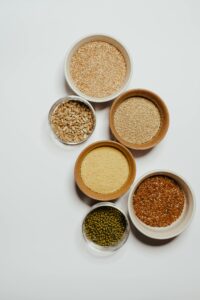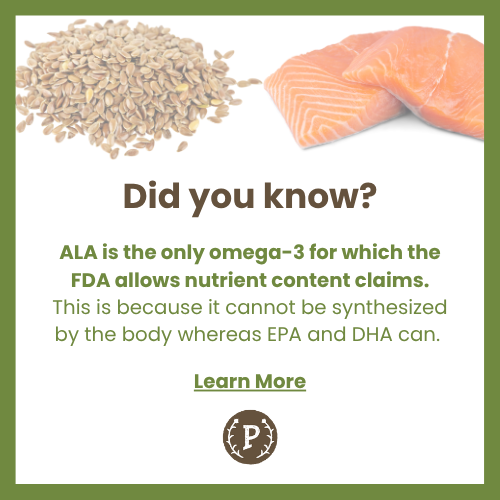While flaxseed has several important bioactive compounds for human health, its omega-3 fatty acid content stands out. This is because flaxseed has the highest alpha-linolenic acid (ALA)—a plant-derived omega-3—content of any whole food source. A two-tablespoon serving of milled flaxseed has 3000 mg of ALA.
While fish oil has dominated the conversation around omega-3s over the past few decades due to its high eicosapentaenoic acid (EPA) and docosahexaenoic acid (DHA) content, flaxseed and other sources of ALA provide some amazing health benefits.
What are omega-3 fatty acids?

Omega-3 fatty acids and omega-6 fatty acids are both polyunsaturated fats. Polyunsaturated fats have more than one double carbon bond while monounsaturated fats have one, and saturated fats have none.
Foods high in omega-3 fatty acids include seafood, flaxseed, chia seed, and walnuts. Examples of foods high in omega-6 fatty acids are safflower and canola oil, walnuts, sunflower seeds, and tofu. Both omega-3 fatty acids and omega-6 fatty acids are necessary for the body. However, due to changes in modern agriculture, a typical Western diet has as much as 20 times more omega-6 than omega-31. This imbalance is due to the widespread use of canola, soybean, corn, and other vegetable oils, which are all high in omega-6 fat. These oils are used in cooking and as ingredients in processed food and in animal feed which impacts the fatty acid profile of meat, eggs, and fish2.
The function of omega-3 fatty acids in the body
Omega-3 fatty acids are in every cell in your body. They are important components of the cell membrane and receptors and are also involved in blood clotting, relaxation and contraction of the artery walls, and inflammation3. Important areas of the body such as the retina, brain, and myocardium (muscle wall of the heart) have higher concentrations of omega-3s in their cell walls4.
Types of omega-3 fatty acids
The three types omega 3 fatty acids are alpha-linolenic acid (ALA), eicosapentaenoic acid (EPA), and docosahexaenoic acid (DHA). ALA is found in plants, seeds, and nuts as well as omega-3 fortified foods such as bread or eggs. EPA and DHA mostly are found in fish and other marine food sources. Your body can convert ALA into EPA and DHA. However, conversion efficiency is dependent on the individual’s genetics, age, gender, and omega-6 fatty acid intake5.
Omega-6/Omega-3 Ratio
Evidence suggests that humans evolved on a diet with an omega-6 to omega-3 ratio around 1:11. Today, a typical western diet has an average omega-6:3 ratio as high as 20:11. While the human diet has changed dramatically, human biology has not6. Therefore, it is unsurprising that a severe imbalance of these fatty acids is detrimental to health.
While omega-6 fat is necessary, too much can contribute to chronic inflammation which has been linked to heart disease, obesity, diabetes, cancer, and other diseases. This is because omega-6 is involved in the synthesis of pro-inflammatory eicosanoids. A proper balance of omega-6 fatty acids and omega-3 fatty acids is necessary for optimal health.
Another problem with high omega-6 intake is that it limits the synthesis of EPA and DHA from ALA5.
“Evidence suggests that humans evolved on a diet with an omega-6:3 ratio around 1:1. Today, a typical western diet has an average omega-6:3 ratio as high as 20:1.”
Conversion of ALA to EPA/DHA
It has been widely reported that the conversion of ALA to EPA and DHA is low. This is why people are encouraged to consume fish or fish oil which is rich in pre-formed EPA and DHA. However, new research, along with existing knowledge on the conversion to long-chain polyunsaturated fatty acids, has demonstrated that this recommendation does not capture the full story.
One way to examine ALA conversion is to look at populations who consume little to no fish (one of the only natural sources of EPA and DHA). Surprisingly, plasma concentrations of DHA in vegans are only 0-40% lower than those who consume fish despite having no DHA in their diet7. Vegan and vegetarian populations also do not have an increased risk for neurological disorders which are thought to be associated with low DHA levels7. Furthermore, it is hypothesized that a primary source of omega-3’s for paleolithic and neolithic people was the fat of wild animals and plants which contained very high levels of ALA8, 9.
Another reason why ALA conversion to EPA and DHA may be underestimated, is because of the high omega-6:3 ratio prevalent today. Linoleic acid (LA) is an omega-6 which is converted into arachidonic acid (AA) by the body. This conversion requires the same enzymes needed to convert ALA to EPA and DHA. Therefore, a diet significantly higher in LA (omega-6) than ALA (omega-3), will reduce the synthesis of long-chain polyunsaturated fatty acids from ALA. Studies have supported this conclusion, reporting that increased ALA consumption and decreased LA consumption leads to higher levels of EPA5.
New research on synthesis of EPA and DHA from dietary ALA has also emerged in recent years. Three studies conducted in mice and rats have demonstrated that DHA synthesis from ALA is potentially far more efficient than previously thought7, 10, 11.
The first study7 found that despite high differences in body DHA accretion, there was no difference in brain DHA accretion between rats on an ALA-only or DHA-only diet. This suggests that DHA derived from ALA may be sufficient to supply the brain.
Another recent study10 conducted in male and female mice, found that serum measures (measure of DHA in the blood) of DHA synthesis from ALA severely underestimate whole-body DHA synthesis (synthesis of DHA in body tissues). The results of this study suggest that DHA synthesis from ALA is more than 47-fold higher than previous estimates. It is speculated that ALA is stored in fat, muscle, and skin tissues where it contributes to DHA synthesis.
A third study11 found that dietary DHA can reduce DHA synthesis in the liver. Furthermore, when there is low dietary DHA intake, the brain gets DHA synthesized from ALA instead. The study also found that there was no significant difference in brain DHA between mice fed an ALA-only, DHA-only, or ALA + DHA diet. These results indicate that the body may be able to increase ALA conversion to DHA when necessary.
It has also been suggested that previous methods of measuring ALA conversion have underestimated DHA synthesis and that a new method, steady-state infusion of stable isotope-labeled ALA, may provide different results12.
AlA Omega-3 and Human Health
Numerous studies and clinical trials have examined the impact of ALA omega-3 on human health. Studies have shown that ALA Omega-3 from flaxseed can support heart health, blood sugar control, cognition, and more have been identified. To read more about the wealth of clinical studies and trials regarding ALA Omega-3 and flaxseed, we encourage you to head to FlaxResearch.com.

conclusion
Despite an abundance of studies and articles promoting the incredible benefits of increased omega-3 consumption, intake levels have not changed much over the past several decades. Furthermore, the widespread promotion of fish oil and fresh fish for their high omega-3 content, has not led to increased fish consumption, and the average daily intake of omega-3 remains just 100-135 mg/day13. Since the attention on fish oil has not increased omega-3 levels, perhaps it is time to refocus on plant sources of omega-3 which tend to be cheaper and easier to incorporate into everyday life.

Flaxseed is an excellent source of omega-3 for those who don’t like fish, can’t afford it, or have an allergy or dietary restriction. Milled flaxseed or flaxseed milk can easily be incorporated into your daily routine in foods such as smoothies, protein shakes, oatmeal, baked goods, yogurt, and more. There doesn’t need to be a sacrifice of benefits either, as ALA has demonstrated powerful health outcomes in numerous studies. Combined with other sources of omega-3 fatty acids, flaxseed can go a long way in helping to reverse the impact of excessive omega-6 in our modern diets.
Notes
[1] Artemis P Simopoulos, “An Increase in the Omega-6/Omega-3 Fatty Acid Ratio Increases the Risk for Obesity,” Nutrients, 8, 3 (2016):128, doi: 10.3390/nu8030128
[2] Artemis P Simopoulos, The Return of W3 Fatty Acids into the Food Supply: Land-Based Animal Food Products and Their Health Effects. Karger Medical and Scientific Publishers, 1998.
[3] “Omega-3 Fatty Acids: An Essential Contribution,” Harvard School of Public Health, Accessed April 4, 2025, https://nutritionsource.hsph.harvard.edu/what-should-you-eat/fats-and-cholesterol/types-of-fat/omega-3-fats/
[4] Marc E Surette, “The science behind dietary omega-3 fatty acids,” CMAJ, 178, 2 (2008): 177-180, doi: 10.1503/cmaj.071356
[5] Kelley Fitzpatrick, “Conversion of Alpha Linolenic Acid to Longer-Chain Omega 3 Fatty Acids,” FlaxResearch.com, Published December 26, 2018, https://flaxresearch.com/2018/12/conversion-of-alpha-linolenic-acid-to-longer-chain-omega-3-fatty-acids/
[6] SB Eaton, SB Eaton III, MJ Konner, “Review Paleolithic nutrition revisited: A twelve-year retrospective on its nature and implications,” Eur J Clin Nutr, 51, (1997): 207-216 doi: 10.1038/sj.ejcn.1600389
[7] Anthony F. Domenichiello, et al. “Whole body synthesis rates of DHA from a-linolenic acid are greater than brain DHA accretion and uptake rates in adult rats,” Journal of Lipid Research, 55, 1 (2014): 62-74, https://www.jlr.org/article/S0022-2275(20)31742-9/fulltext
[8] Jose L. Guil-Guerrero, et al. “The Fat from Frozen Mammals Reveals Sources of Essential Fatty Acids Suitable for Paleolithic and Neolithic Humans,” PL0S ONE 9, (2014), doi: 10.1371/journal.pone.0084480
[9] Ram Bahadur Singh, Fabien Demeester, Agnieszka Wilczynska, “The Tsim Tsoum Approaches for Prevention of Cardiovascular Disease,” Cardiology Research and Practice, 1, (2010), doi: 10.4061/2010/824938
[10] Ruxandra D. Rotarescu, et al., “Serum measures of docosahexaenoic acid (DHA) synthesis underestimates whole body DHA synthesis in male and female mice,” J Nut Bio, 131, (2024), doi: 10.1016/j.jnutbio.2024.109689
[11] Adam H. Metherel, et al., “Dietary docosahexaenoic acid (DHA) downregulates liver DHA synthesis by inhibiting eicosapentaenoic acid elongation,” Journal of Lipid Research 65, 6 (2024), doi: 10.1016/j.jlr.2024.100548
[12] Anthony F. Domenichiello, Alex P. Kitson, Richard P. Bazinet, “Is docosahexaenoic acid synthesis from a-linolenic acid sufficient to supply the adult brain?” Progress in Lipid Research 59, (2015): 54-66, doi: 10.1016/j.plipres.2015.04.002
[13] Kelley Fitzpatrick, “Dietary long chain omega 3 fatty acids intakes remain low supporting the need for flaxseed,” FlaxResearch.com, https://flaxresearch.com/2020/01/dietary-long-chain-omega-3-fatty-acids-intakes-remain-low-supporting-the-need-for-flaxseed/
